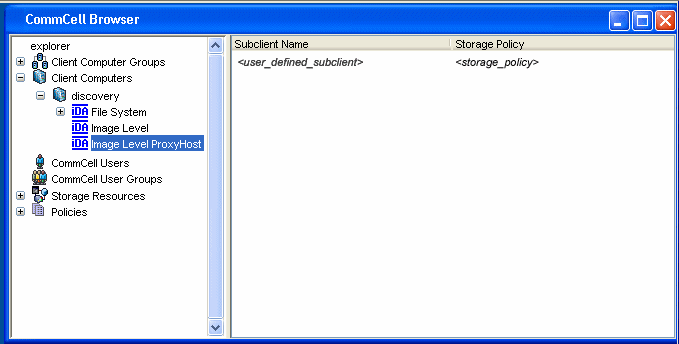
| This feature/product/platform is deprecated in this release. See Deprecated Features, Products, and Platforms for more information. |
Choose from the following topics:
Unlike the file system iDataAgent which backs up folders and files, the Image Level ProxyHost iDataAgent backs up complete volumes or mount points, and restores them using Volume Level Restore; for certain operating systems it is also able to restore folders and files using a File Level Restore. Generally, only blocks that contain data are backed up; empty blocks are not, with the following notes:
The Image Level ProxyHost iDataAgent enables the use of third party vendors' split mirrors and snapshot technology to greatly reduce the effects of backup operations on the production server. This iDataAgent can use third party software to create a point-in-time copy of the production server data mounted on to the backup host and the backup is started from this secondary host. The Image Level ProxyHost software performs the following functions:
The Image Level ProxyHost iDataAgent is installed on the production server only, but the same File System iDataAgent (i.e., Windows File System) and Image Level iDataAgent must be installed on both the production server and backup host.
The following file system types are supported for backup and restore operations:
It is possible to restore data from one file system type to another through Volume Level Restore. The following such Volume Level Restores are supported:
After such a restore, sometimes Windows Explorer may still show the volume having the same file system type as before the restore, even though Computer Management shows the new (correct) type. After a reboot, Windows Explorer will show the correct file system type. For File Level Restores, only data backed up from NTFS volumes can be browsed and restored to NTFS or FAT volumes.
The following table lists the file systems and restore types supported by the Image Level ProxyHost iDataAgent for Unix, for each supported operating system:
The following table lists the file systems and restore types supported by the Image Level iDataAgent for Unix, for each supported operating system:
| File System | Operating System | Back Up Data Blocks Only |
Volume Restore |
File Restore |
| Unix File System (UFS) Includes read-only partitions on Unix, as long as the production server and backup host are configured as the same computer |
Solaris | X | X | X |
| Extent 2 File System (ext2) | Linux | X | X | X |
| Extent 3 File System (ext3) | Linux | X | X | X |
| VERITAS File System (VxFS) | Solaris | X | ||
| Veritas Volume Manager (VxVM 3.1 and 3.5) | Solaris | X | X |
|
When the Image Level ProxyHost iDataAgent is installed, the following levels are automatically created in the CommCell Browser:

|
discovery:
Client Image Level ProxyHost: Agent |
<user_defined_subclient>: User-defined subclients |
To perform a data protection operation using this Agent a specific Product License must be available in the CommServe® Server.
Review general license requirements included in License Administration. Also, View All Licenses provides step-by-step instructions on how to view the license information.
The Image Level ProxyHost iDataAgent is designed to work in conjunction with the following snapshot engines, which provide snapshot functionality for data protection operations:
For more detailed snapshot support information, refer to Support Information - Snapshot Engines.
The Image Level ProxyHost iDataAgent uses LAN Copy Manager to read block-level data directly from the specified volume(s) on the backup host and transmit it to the specified MediaAgent (which can be installed on the same machine, thus avoiding LAN use.) For more information, see Copy Managers.